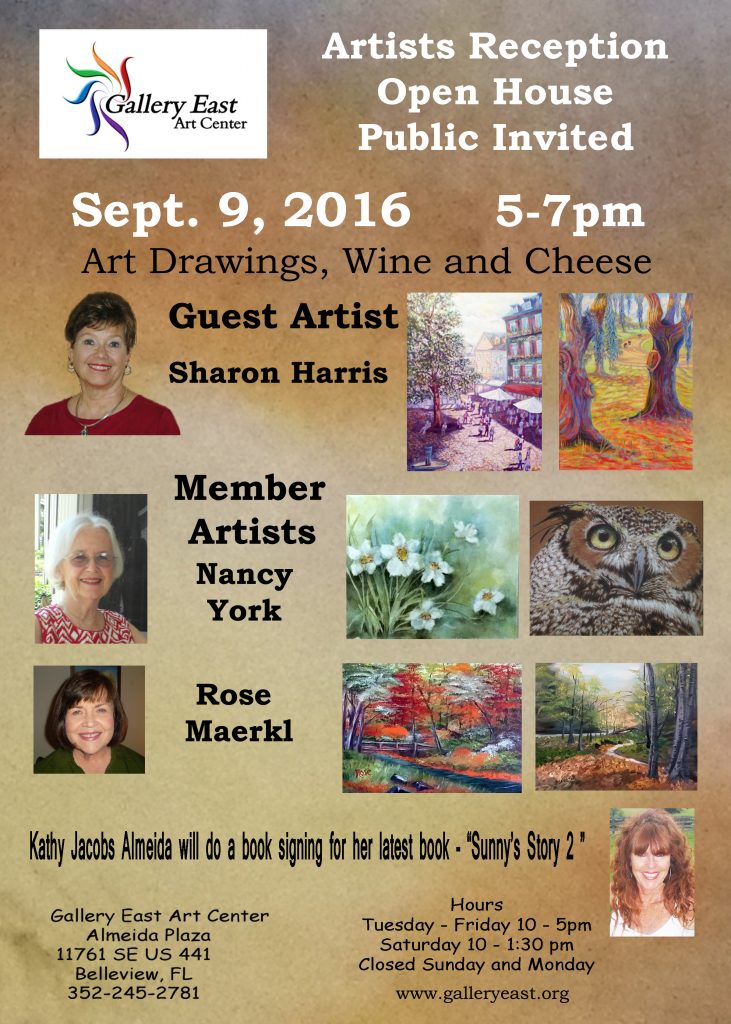August 30th, 2016
 Gallery East Arts Center Alameda Plaza 1176 SE. US 441 Bellevue, Florida
Gallery East Arts Center Alameda Plaza 1176 SE. US 441 Bellevue, Florida
352-245-2781
Hours Tuesday through Friday 4:50 PM Saturday 10 to 1:30 PM closed Sunday and Monday www.galleryeast.org
Artist reception open house Public invited September 9, 2016 five through 7 PM art drawings wine and cheese
Guest artist Sharon Harris
Member artist Nancy York and Rose Maerkl
Kathy Jacobs Almeida will do a book signing for her latest book Sonny’s Story 2
Tags: Gallery East Art Center, Open House, Sharon Harris
Posted in Events | Comments Off on Gallery East Arts Center Artist Reception Public Invited September 9, 2016 5-7 PM
October 17th, 2012
Blast from the past–just back from my 50th class reunion with lots of great stuff to paint of the DFW area; but oh what a mess the roads are!!!! 6.5 million people are too many for me to get along with, so I think I ‘ll just stay in Florida.
Posted in Events | Comments Off on FT Worth/Dallas–OMG
August 1st, 2012
Acrylics class Mondays, 1:00 to 3:00 will start October 1, 2012 and end December 10, 2012, at the Art Center of Citrus County. Registration is $35 for the semester. Registration opens August 13, 2012, limit 12 students, so register early at the Art Center, 352-746-7606. Materials not included, materials list available on request.
Posted in Acrylic Class | Comments Off on Brushwork with Acrylics Class
January 17th, 2011
Tips from Today’s Session
Students, following are a couple of things to remember as you develop the value studies and plan for your final canvas:
- Begin working your idea as a sketch, on sketch paper
- Ideally, put a ground on your intended painting support (canvas paper, poster board) to begin your “value study” before you apply glaze washes of pigment
- If you began by sketching your idea on the support (no sketch paper, see 4) without putting a ground on it you need to seal the pencil drawing by putting a glaze wash of pigment/water on the support before you can begin to place darker values on to the line study. If you don’t you will obliterate your image.
- Don’t try to put the glaze wash on sketch paper—the paper is not a sturdy support and your image is likely to be washed away and the paper will become crumply’
- If your support is water color paper use 140lb cold press, size it with water, dry it and tape it flat
- Once you have your image secure under a transparent glaze wash of pigment, begin adding value changes (shading) in the areas that you wish to be darker and/ or a different pigment color. Keep the glaze washes transparent, even if they are dark.
- If you get to dark in an area, put a white transparent glaze wash over the area, or the entire support if required, and go at it again
- Once you feel satisfied with the value ranges established on that support—have another support ready to draw on and begin a different combination of glaze washes using the color charts you made to select your color scheme from.
- You should try three or four color schemes and possibly a rearrangement of your original sketch idea to fully develop the plan for your painting.
Tags: Acrylic Class Info
Posted in Acrylic Class | Comments Off on Doing A Value Study
January 11th, 2011
The class went great yesterday. Remember, we didn’t have time to make a chart mixing your primary colors with your secondary colors and then changing each of the mixes value by tinting the mix with white to change the value, so make that chart.
Also remember that your blue, green and yellow charts will use a cool (Alizarin Crimson) red and a warm red (cadmium med) for your temperature changes. The yellow chart for landscape hues use burnt sienna for the warm yellow and the ultramarine blue for the cool temperature changes.
Always fill the entire square, don’t leave any white edges and experiment with the temperature changes by tinting them with white to change their values. I’m open to your comments or questions.
Tags: Acrylic Class Info
Posted in Acrylic Class | Comments Off on Mixing Colors
January 4th, 2011
Many of my students ask: what is the difference between the Old Master’s paintings and those that were done during the nineteenth century by the Impressionist, didn’t they both work in oils? The difference is not whether they used oils, watercolor or gouache: it lies in the methodology they used in applying the pigments combined with where they worked.
The Old Masters worked in their studios and most often in a method referred to as grisaille (gray tones) to establish values first and then they added color glazes over the values. The Impressionists worked in plein aire (outdoors/in the streets) in a method known as Alla Prima, a method of working directly on the support (canvas or board) with a loaded brush of full pigment. The location of where they worked affected their subject matter, which is a whole different story.
Today, artists often work with both methods and in both places by sketching in plein aire and taking a photograph home to finish the work in the studio. This system was advanced also by an Impressionist, Gustave Caillebotte.
Tags: Acrylic Class Info
Posted in Acrylic Class | Comments Off on Old Master’s Methods
December 28th, 2009
Today reading this month’s Ceramics Monthly ran across a good graphic on why increasing silica (flint) reduces running in a glaze formula.
Tags: Glazes
Posted in Glazes | Comments Off on Silica
 Gallery East Arts Center Alameda Plaza 1176 SE. US 441 Bellevue, Florida
Gallery East Arts Center Alameda Plaza 1176 SE. US 441 Bellevue, Florida